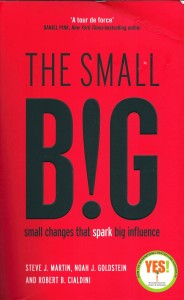The one-sentence summary
Small changes can have a disproportionately big influence.
WHAT THE BOOK SAYS 
- Persuasion science shows that, in today’s information overloaded world, it’s often the smallest changes that can have the biggest influence.
- The book contains over 50 deceptively simple suggestions and explains the scientific research behind them.
- There’s nothing devious about these suggestions – they are for anyone who wishes to change the behaviour of others effectively, efficiently, and ethically.
- In many cases, the alterations cost nothing but can, for example, save governments millions.
- The key to all of this are three simple yet powerful underlying human motivations:
1. To make accurate decisions as efficiently as possible
2. To affiliate with and gain the approval of others
3. To see oneself in a positive light
- Small changes are additionally powerful because they ‘fly under the radar.’
- They rarely raise suspicion or attention, and simply go quietly about their business.
WHAT’S GOOD ABOUT IT
- There are some persuasive examples here:
- People proof: In 2009 the UK government was able to collect £200m extra tax simply by truthfully stating on the correspondence that “most UK citizens pay their tax on time.” This played to peoples’ inherent desire to follow others, and make an accurate decision as efficiently as possible.
- Head start: People tend to be more motivated to undertake a task they have already started, rather than start from scratch. So, customers told they would get a free car wash after eight washes are twice as likely to complete the purchases if given a loyalty card with ten spaces and two stamps already affixed. They feel they are underway.
- Online reviews: Contrary to normal belief, negative reviews are viewed as more helpful and persuasive than positive ones. Positive reviews are at their best when written the same day, so restaurants for example should include a suggestion to do this on their bills.
WHAT YOU HAVE TO WATCH
- The chapters are somewhat annoyingly titled with rhetorical questions. Each chapter does of course answer them, but you have to rummage for every answer. The format would have been easier to reference if each chapter had a one-sentence answer at the end, or if the answer were the chapter heading.
- There are 52 examples here – arguably too many to absorb in detail and enact regularly.
